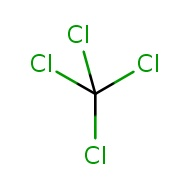Uses of Tetrachloromethane
In past tetrachloromethane has been used as fire extinguisher as it extinguishes the flames and prevents the fire. Its vaporization causes the combustion reaction to stop. Tetrachloromethane without the presence of hydrogen atom is an ideal choice for NMR spectroscopy and is the use-able option for the infrared spectroscopy due to its solvent properties. For the synthesis of chlorine-based organic compounds, a tetrachloromethane is a good option. Tetrachloromethane is a non-polar compound and is an excellent solvent for the nonpolar substances. In the past, tetrachloromethane was widely used for making the refrigerants and propellants for aerosol cans such as CFC. Also, it was commonly used as a degreasing agent, as a dry-cleaning agent, and as a pesticide. Due to hazardous effects, many of the uses of tetrachloromethane have been banned and now it has some limited applications in the specific industries. Tetrachloromethane is also used as intermediate for various chemicals. In past tetrachloromethane was also used by the farmers to control the attack of liver fluke in the sheep.

Environmental Effects of Tetrachloromethane
Tetrachloromethane is toxic material and its use is highly suppressed even though it has a wide range of applications. Tetrachloromethane is a greenhouse gas and it depletes the ozone and has a significant role to cause environmental damage and global warming. It is a volatile organic compound but it does not react so it does not have any contribution to the formation of ground-level ozone. It tetrachloromethane is spilled on the soil then it is rapidly evaporated although some amount is leached to the groundwater and causes the contamination. Tetrachloromethane is extremely stable in the lower atmosphere with a residence time of up to 30-50 years and it causes the ozone depletion. Due to its chemical stability, it can reach the upper atmosphere and, in the stratosphere, there is intense ultraviolet radiation which causes its break down to the chlorine. Then upon reaction with ozone, this chlorine causes the depletion of the ozone layer which protects the life from the harmful ultraviolet radiation. It is a weak greenhouse gas and significantly contributes to global warming.
If tetrachloromethane is present in normal concentrations in the environment, it does not cause serious health concerns. At elevated levels, it can cause severe damage to the liver, kidneys and central nervous system. It may cause cancer as well. Exposure to the elevated level of tetrachloromethane may cause coma or even death. Tetrachloromethane is also toxic to aquatic organisms.